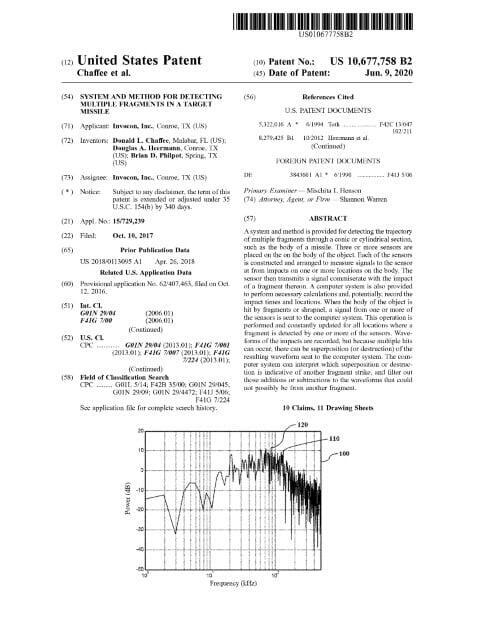
Overview
This patented system equips a missile-like target with a gridless array of three or more sensors and a dedicated processing pipeline that separates and locates multiple, nearly simultaneous fragment impacts. Filed in October 2017 and granted in June 2020, the invention replaces fragile wire/optical grids with acoustic and RF-based impact modeling, digital interpolation, and a multi‑user detection framework to disentangle overlapping waveforms. Inventors based in Malabar, FL; Conroe, TX; and Spring, TX developed a detector that serially estimates individual impulse responses, subtracts identified signatures, and iterates to expose subsequent hits. The approach combines multilateration (triangulation) with convolutional‑coding ideas and Viterbi‑style decoding to map time‑ordered sensor detections to unique fragment identities and trajectories. The result is reliable impact counting, time‑of‑arrival tagging, and impact‑location confidence scoring even in high‑fragmentation “shrapnel kill” scenarios.
The drafting demonstrates technical depth in modeling impulse responses, handling multipath reflections, and bounding search complexity for real‑time operation, reflecting strong claims coverage around model‑based subtraction, detection statistics, and triangulation solutions.
Key Features
- Gridless acoustic/RF hit detection robust to multiple overlapping impacts
- Model‑based subtraction and interpolation for sub‑sample timing accuracy
- Convolutional‑style decoding to associate sensor detections with fragments
- Multilateration/triangulation with confidence metrics for impact localization
This innovation improves lethality assessment and trajectory reconstruction for missile testing and defensive systems, with clear applicability to aerospace defense testing and high‑fidelity impact monitoring in other critical structures.



